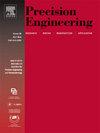Toolpath smoothing and motion planning for the diamond turning of microlens arrays with improved uniformity
IF 3.5
2区 工程技术
Q2 ENGINEERING, MANUFACTURING
Precision Engineering-Journal of the International Societies for Precision Engineering and Nanotechnology
Pub Date : 2025-05-12
DOI:10.1016/j.precisioneng.2025.05.005
引用次数: 0
Abstract
Microlens arrays fabricated by ultra-precision machining commonly suffer from surface nonuniformity, which results in the inconsistency and degradation of their optical performances. One major possible cause is the uneven distribution of toolpath kinematic characteristics, especially the excessive local acceleration and jerk values concentrated at lens edges. To address the issue, this study proposes an optimization strategy comprising toolpath smoothing and motion planning. The toolpath directly generated using equal-angle discretization is first processed by spline interpolation-based smoothing to eliminate the abrupt turnings at lens edges. The smoothed toolpath is then optimized by a replanning process which adaptively adjusts the cutter location point (CLP) density according to local curvature. Lastly, the replanned toolpath and CLPs are further finely tuned by genetic algorithm in which acceleration and jerk feedbacks are integrated using penalty terms. Theoretical analysis demonstrates greatly reduced acceleration and jerk peak values by over 90 % compared to equal-angle discretization. Significantly improved surface uniformity, both among differently located lenses and within a single lens, is verified by experimental investigation. These findings provide a potential solution to the nonuniformity of machined microstructured surfaces, enabling the advanced and consistent performances of optical systems.
提高微透镜阵列金刚石车削均匀性的刀路平滑和运动规划
采用超精密加工技术制备的微透镜阵列通常存在表面不均匀性问题,从而导致微透镜阵列光学性能的不一致和下降。一个主要的可能原因是刀具轨迹运动特性分布不均匀,特别是集中在透镜边缘的过多的局部加速度和抖动值。为了解决这一问题,本研究提出了一种包含刀具轨迹平滑和运动规划的优化策略。首先对等角离散直接生成的刀具轨迹进行基于样条插值的平滑处理,以消除透镜边缘的突然转弯。然后通过根据局部曲率自适应调整刀具定位点(CLP)密度的重新规划过程优化光滑的刀具路径。最后,通过遗传算法对重新规划的刀具轨迹和clp进行进一步微调,其中使用惩罚项集成加速度和推力反馈。理论分析表明,与等角离散相比,大大降低了加速度和加速度峰值90%以上。显著改善表面均匀性,无论是在不同位置的透镜和在单一透镜,是通过实验调查验证。这些发现为机械加工微结构表面的不均匀性提供了一个潜在的解决方案,使光学系统的先进和一致的性能成为可能。
本文章由计算机程序翻译,如有差异,请以英文原文为准。
求助全文
约1分钟内获得全文
求助全文
来源期刊
CiteScore
7.40
自引率
5.60%
发文量
177
审稿时长
46 days
期刊介绍:
Precision Engineering - Journal of the International Societies for Precision Engineering and Nanotechnology is devoted to the multidisciplinary study and practice of high accuracy engineering, metrology, and manufacturing. The journal takes an integrated approach to all subjects related to research, design, manufacture, performance validation, and application of high precision machines, instruments, and components, including fundamental and applied research and development in manufacturing processes, fabrication technology, and advanced measurement science. The scope includes precision-engineered systems and supporting metrology over the full range of length scales, from atom-based nanotechnology and advanced lithographic technology to large-scale systems, including optical and radio telescopes and macrometrology.

 求助内容:
求助内容: 应助结果提醒方式:
应助结果提醒方式:


